2017 KIA NIRO QUICK TAKES
2017 KIA NIRO QUICK TAKES
The all-new 2017 Kia Niro is a no-compromise vehicle that combines driving enjoyment with eye-catching design, functional utility and hybrid efficiency.
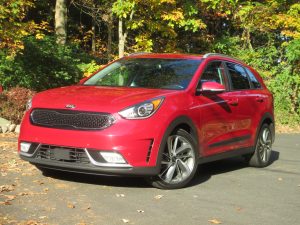 The all-new Niro strikes the perfect balance for today’s consumers and stakes claim to a unique position between the hybrid-electric vehicle and CUV segments.
The all-new Niro strikes the perfect balance for today’s consumers and stakes claim to a unique position between the hybrid-electric vehicle and CUV segments.
“We’re excited about the Niro,” said Orth Hedrick, vice president product planning KMA. “It’s fantastic – exceptional fuel economy, great looks, the usefulness and security of a compact utility and it’s fun to drive. The Niro really does set a new standard in the market.”
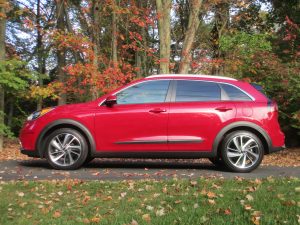 Designed to provide a new generation of environmentally conscious, adventurous and design-loving drivers everything they want but was previously unavailable, the Niro’s long list of features and attributes includes:
Designed to provide a new generation of environmentally conscious, adventurous and design-loving drivers everything they want but was previously unavailable, the Niro’s long list of features and attributes includes:
- Exceptional fuel efficiency — up to 50 mpg combined — and, as a result, reduced emissions.
- An innovative hybrid system featuring a 6-speed dual clutch automatic transmission with Sport Mode, to provide a more dynamic and engaging driving experience, while delivering extremely efficient operation.
- A spacious cabin with lots of room for occupants and their gear.
- Kia’s full array of driver assistance features – advanced high-strength steel structure, seven airbags, available Autonomous Emergency Braking (AEB), Blind Spot Detection (BSD), Rear Cross Traffic Alert (RCTA), Lane Change Assist (LCA) and Lane Departure Warning (LDW).
- The Niro doesn’t look like other hybrids, its eye-catching design is athletic – strong, sculpted and modern.
- It’s well-equipped – Standard UVO3 with Apple CarPlaTM, Android AutoTM4 and a 7-inch touchscreen and available Smart Cruise Control, navigation and a Harman Kardon® premium audio system.
An “Un-Hybrid” Design
Designed at Kia’s design centers in Irvine, California, and Namyang, Korea, the Niro demonstrates that owners don’t have to sacrifice emotionally engaging design or functional utility in the name of efficiency.
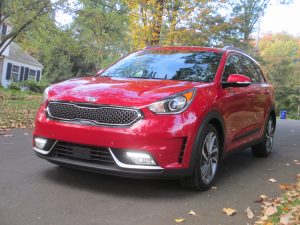 Wide and low proportions with a long wheelbase and short overhangs yield an athletic stance, while aggressively shaped headlights and a new interpretation of Kia’s tiger nose grille define the front theme.
Wide and low proportions with a long wheelbase and short overhangs yield an athletic stance, while aggressively shaped headlights and a new interpretation of Kia’s tiger nose grille define the front theme.
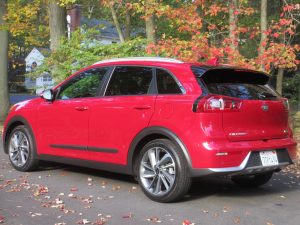 The Niro’s profile is distinguished by its strong shoulders, defined wheel arches, rocker-panel cladding, and roof rails. The strong and sporty rear theme is enabled by the wide stance, rear skid plate, and multi-element horizontal LED tail lamp graphic.
The Niro’s profile is distinguished by its strong shoulders, defined wheel arches, rocker-panel cladding, and roof rails. The strong and sporty rear theme is enabled by the wide stance, rear skid plate, and multi-element horizontal LED tail lamp graphic.
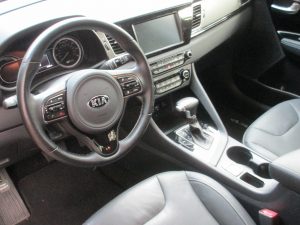 The instrument panel is uncluttered and clean, with colorful and informative gauges at the forefront and perfectly positioned primary and secondary controls falling readily to hand. Interior roominess comes by way of the Niro’s generous 106.3-inch wheelbase, body height, and wide stance, which affords ample leg-, head- and shoulder-room.
The instrument panel is uncluttered and clean, with colorful and informative gauges at the forefront and perfectly positioned primary and secondary controls falling readily to hand. Interior roominess comes by way of the Niro’s generous 106.3-inch wheelbase, body height, and wide stance, which affords ample leg-, head- and shoulder-room.
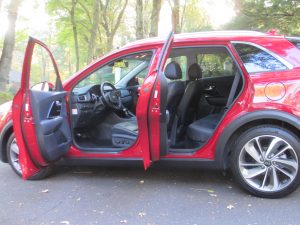 While the clever packaging of the high-voltage battery assists in delivering a desirable driving experience, its location underneath the rear seats also increases cabin and cargo space and allows a flat load floor.
While the clever packaging of the high-voltage battery assists in delivering a desirable driving experience, its location underneath the rear seats also increases cabin and cargo space and allows a flat load floor.
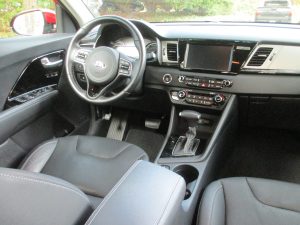 In addition to spaciousness and comfort, ensuring a quiet interior environment was also a key development focus for engineers. Noise and vibration countermeasures were employed to minimize at the source, with specially designed engine mounts, equal-length driveshafts, and even by adding a damper inside the steering wheel hub to minimize vibrations felt in the steering wheel. Copious insulation in the Niro’s front structure, optimized suspension bushing stiffness, careful body sealing, and application of expanding foam inside the A- and B-pillars all prevent road and tire noise from entering the cabin. Furthermore, acoustic windshield glass and carefully shaped side mirrors help mitigate wind noise.
In addition to spaciousness and comfort, ensuring a quiet interior environment was also a key development focus for engineers. Noise and vibration countermeasures were employed to minimize at the source, with specially designed engine mounts, equal-length driveshafts, and even by adding a damper inside the steering wheel hub to minimize vibrations felt in the steering wheel. Copious insulation in the Niro’s front structure, optimized suspension bushing stiffness, careful body sealing, and application of expanding foam inside the A- and B-pillars all prevent road and tire noise from entering the cabin. Furthermore, acoustic windshield glass and carefully shaped side mirrors help mitigate wind noise.
Strong and Light Core
The platform underpinning the Niro has been specifically engineered to accommodate the gasoline-electric hybrid powertrain, and with 53 percent of Advanced High Strength Steel (AHSS), including reinforcement in the A- and B-pillars as well as the roof rails, it is both a lightweight and durable structure.
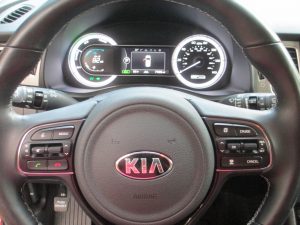 Extensive use of hot-stamped components and industrial joint adhesive increase torsional rigidity and improve structural integrity. As such, Kia is targeting the Niro to earn top honors from the National Highway Traffic Safety Administration (NHTSA) and Insurance Institute of Highway Safety (IIHS).
Extensive use of hot-stamped components and industrial joint adhesive increase torsional rigidity and improve structural integrity. As such, Kia is targeting the Niro to earn top honors from the National Highway Traffic Safety Administration (NHTSA) and Insurance Institute of Highway Safety (IIHS).
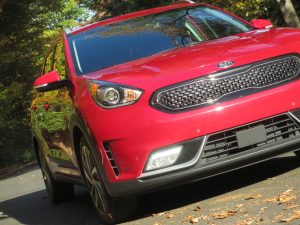 Weight reduction was a critical Niro development aspect, and in addition to the body, AHSS was also used to engineer other elements, including lightweight seat frames.
Weight reduction was a critical Niro development aspect, and in addition to the body, AHSS was also used to engineer other elements, including lightweight seat frames.
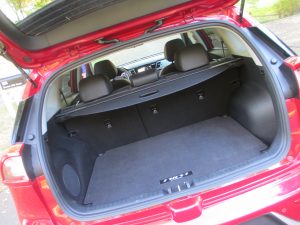 Further, engineers were able to bring down the overall weight by using aluminum for the hood, tailgate and several suspension elements including the front lower control arms, front and rear knuckles, and in the brake calipers. The engineers even eliminated the traditional 12-volt battery to reduce weight, instead utilizing the high-voltage lithium-ion polymer battery.
Further, engineers were able to bring down the overall weight by using aluminum for the hood, tailgate and several suspension elements including the front lower control arms, front and rear knuckles, and in the brake calipers. The engineers even eliminated the traditional 12-volt battery to reduce weight, instead utilizing the high-voltage lithium-ion polymer battery.
Uniquely Engineered Hybrid Powertrain
At the heart of the Niro’s all-new powertrain is a state-of-the-art 1.6-liter GDI four-cylinder engine –- from Kia’s Kappa engine family –- which is engineered specifically for hybrid applications.
 Making 104 horsepower, the new engine marks the first combination of the Atkinson Cycle, cooled exhaust gas recirculation (EGR), GDI and a long-stroke-narrow-bore specification to maximize efficiencyto up to 50 mpg (Combined)1. Efficiency and emissions are further improved via the Niro’s exhaust heat recovery system, which speeds engine warm-up by routing coolant to a heat exchanger in the exhaust system. A 43-hp tractive motor is fitted between the engine and transmission and works in tandem with the gasoline engine to produce a robust 139 horsepower and 195 lb.-ft. of torque.
Making 104 horsepower, the new engine marks the first combination of the Atkinson Cycle, cooled exhaust gas recirculation (EGR), GDI and a long-stroke-narrow-bore specification to maximize efficiencyto up to 50 mpg (Combined)1. Efficiency and emissions are further improved via the Niro’s exhaust heat recovery system, which speeds engine warm-up by routing coolant to a heat exchanger in the exhaust system. A 43-hp tractive motor is fitted between the engine and transmission and works in tandem with the gasoline engine to produce a robust 139 horsepower and 195 lb.-ft. of torque.
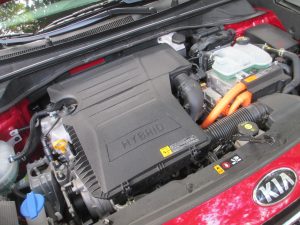 That power is transmitted through a newly developed, second-generation six-speed dual-clutch transmission (DCT), which not only boosts efficiency but is also a key factor to the Niro’s great driving experience. The transmission delivers smooth, quick shifts for a natural and spirited feel, which is in stark contrast to that of other hybrids equipped with continuously variable transmissions. Electric energy and power for the whole system is provided by a compact and lightweight 1.56-kWh Lithium Ion Polymer battery located underneath the rear seat. Because the high-voltage battery is both power and energy dense, it is smaller and lighter than other hybrid batteries, and also allowed engineers to downsize the gasoline engine to further maximize fuel economy and reduce emissions.
That power is transmitted through a newly developed, second-generation six-speed dual-clutch transmission (DCT), which not only boosts efficiency but is also a key factor to the Niro’s great driving experience. The transmission delivers smooth, quick shifts for a natural and spirited feel, which is in stark contrast to that of other hybrids equipped with continuously variable transmissions. Electric energy and power for the whole system is provided by a compact and lightweight 1.56-kWh Lithium Ion Polymer battery located underneath the rear seat. Because the high-voltage battery is both power and energy dense, it is smaller and lighter than other hybrid batteries, and also allowed engineers to downsize the gasoline engine to further maximize fuel economy and reduce emissions.
Driving Fun
The Niro’s simplified parallel hybrid system creates seamless transitions of power delivered to the front wheels, resulting in a very un-hybrid-like driving experience.
 The hybrid system is neither intrusive nor obvious. The Niro accelerates quickly off the line and continues its smooth power delivery, inspiring driver confidence in everyday driving maneuvers such as merging onto the highway.
The hybrid system is neither intrusive nor obvious. The Niro accelerates quickly off the line and continues its smooth power delivery, inspiring driver confidence in everyday driving maneuvers such as merging onto the highway.
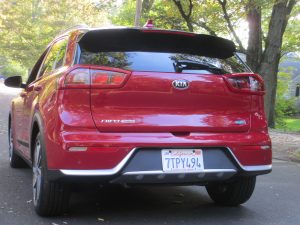 Special attention was also paid to brake feel. Applying lessons learned through development of two generations of Optima Hybrids as well as the fully electric Soul EV, Kia engineers designed the Niro’s regenerative system to seamlessly blend in hydraulic friction braking. Consequently, deceleration feels more consistent and linear than in other hybrids.
Special attention was also paid to brake feel. Applying lessons learned through development of two generations of Optima Hybrids as well as the fully electric Soul EV, Kia engineers designed the Niro’s regenerative system to seamlessly blend in hydraulic friction braking. Consequently, deceleration feels more consistent and linear than in other hybrids.
Advanced Hybrid Technology
The Niro is offered with a suite of advanced driver assistance and convenience technologies, including Blind Spot Detection (BSD) with Rear Cross Traffic Alert (RCTA) and Lane Change Assist (LCA); Smart Cruise Control (SCC); Lane Departure Warning (LDW); and Autonomous Emergency Braking (AEB).
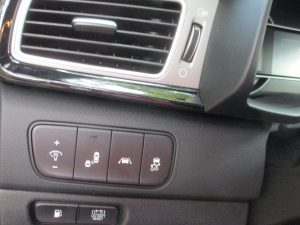 All-new Eco-DAS(Driver Assistance System) features Kia’s first application of Coasting Guide and Predictive Energy Control, which use the navigation system and analysis of the driver’s route to improve efficiency. The Coasting Guide aims at maximizing fuel economy by coaching the driver on when to coast and brake. Predictive Energy Control anticipates topographical changes on the road ahead to actively manage energy flow, seamlessly determining when its best to recharge the battery and when its best to expend stored energy to optimize overall efficiency. Similar systems have been seen on German luxury makes, but it Kia’s is the first system to monitor and adjust for both ascending and descending scenarios. Other notable features include Smart Air Intake, which reduces drag by carefully managing the intake of outside air for the HVAC system, and also an accompanying Auto Defog system that prevents condensation from building on the glass by monitoring cabin air conditions to manage the cycling of the A/C compressor.
All-new Eco-DAS(Driver Assistance System) features Kia’s first application of Coasting Guide and Predictive Energy Control, which use the navigation system and analysis of the driver’s route to improve efficiency. The Coasting Guide aims at maximizing fuel economy by coaching the driver on when to coast and brake. Predictive Energy Control anticipates topographical changes on the road ahead to actively manage energy flow, seamlessly determining when its best to recharge the battery and when its best to expend stored energy to optimize overall efficiency. Similar systems have been seen on German luxury makes, but it Kia’s is the first system to monitor and adjust for both ascending and descending scenarios. Other notable features include Smart Air Intake, which reduces drag by carefully managing the intake of outside air for the HVAC system, and also an accompanying Auto Defog system that prevents condensation from building on the glass by monitoring cabin air conditions to manage the cycling of the A/C compressor.
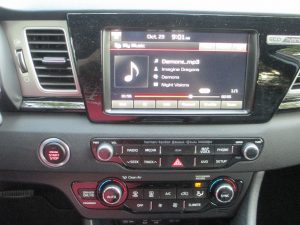 Kia’s award-winning infotainment and telematics system aims to keep Niro drivers connected at all times, with the newest version, UVO3, trickling down from the all-new 2017 Sportage. Complete with AndroidAuto™, Apple CarPlay®, and UVO eServices featuring 14 telematics services, the enhanced system features up to 8 GB of music storage, access to onscreen apps such as Pandora® and Soundhound and Wi-Fi tethering capability. All this is displayed on a 7-inch capacitive touch screen.
Kia’s award-winning infotainment and telematics system aims to keep Niro drivers connected at all times, with the newest version, UVO3, trickling down from the all-new 2017 Sportage. Complete with AndroidAuto™, Apple CarPlay®, and UVO eServices featuring 14 telematics services, the enhanced system features up to 8 GB of music storage, access to onscreen apps such as Pandora® and Soundhound and Wi-Fi tethering capability. All this is displayed on a 7-inch capacitive touch screen.
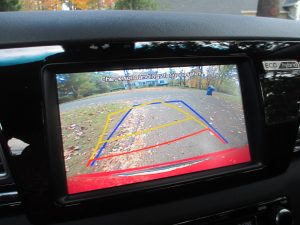 The Niro is the latest vehicle introduced under the Kia Motors EcoDynamics environmentally friendly sub-brand and represents a number of firsts. While it was preceded by clean mobility products such as the Optima Hybrid and Soul EV, Niro is the first Kia to make use of an all-new, dedicated eco-car platform and is an important next step on the path to nearly tripling the brand’s global EcoDynamics line-up by 2020.
The Niro is the latest vehicle introduced under the Kia Motors EcoDynamics environmentally friendly sub-brand and represents a number of firsts. While it was preceded by clean mobility products such as the Optima Hybrid and Soul EV, Niro is the first Kia to make use of an all-new, dedicated eco-car platform and is an important next step on the path to nearly tripling the brand’s global EcoDynamics line-up by 2020.
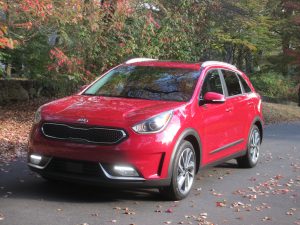 A plug-in hybrid powertrain is due to be added to the car’s line-up later in its life-cycle.
A plug-in hybrid powertrain is due to be added to the car’s line-up later in its life-cycle.
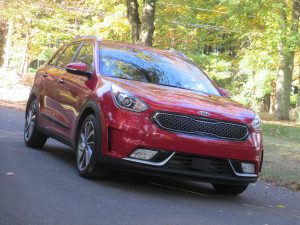 2017 KIA NIRO Touring as shown $32,445.
2017 KIA NIRO Touring as shown $32,445.
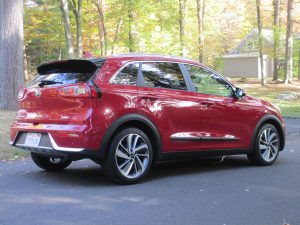 Lower, more economical trims begin at around $24,000.
Lower, more economical trims begin at around $24,000.

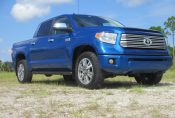 2017 TOYOTA TUNDRA QUICK TAKES
2017 TOYOTA TUNDRA QUICK TAKES 2017 HONDA ACCORD HYBRID QUICK TAKES
2017 HONDA ACCORD HYBRID QUICK TAKES Toyota 4Runner TRD Pro 2017 Review
Toyota 4Runner TRD Pro 2017 Review